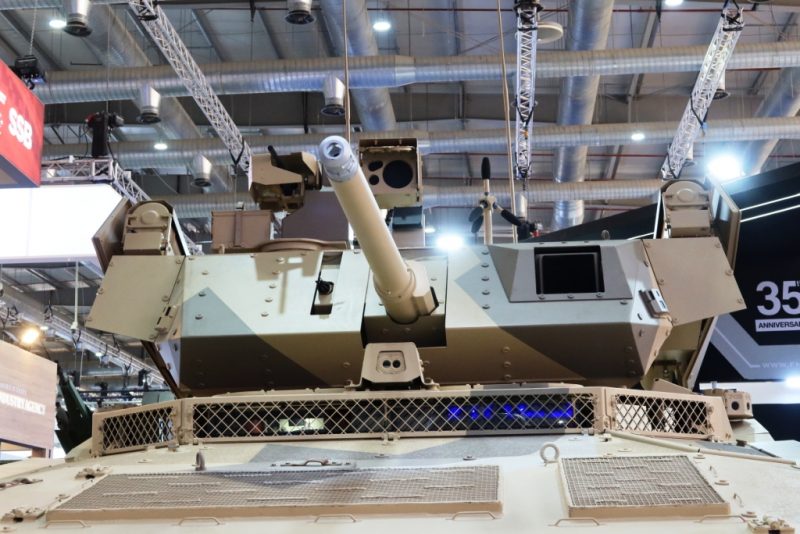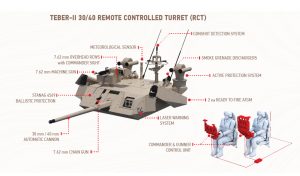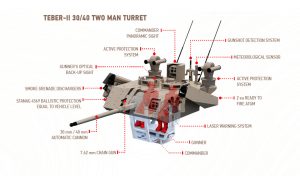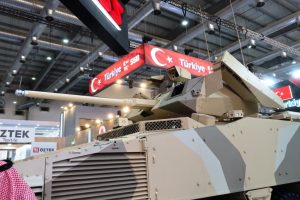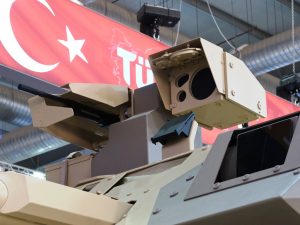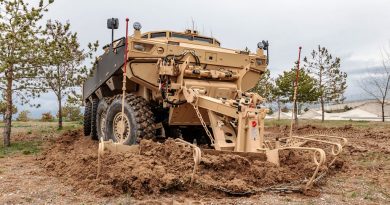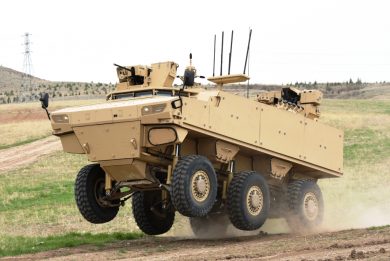WDS 2024 – FNSS unveils the second generation of its Teber medium calibre turret, the Teber-II 30/40
At the second edition of the World Defense Show, FNSS, the JV between the Turkish Nurol Group and BAE Systems, is unveiling the latest iteration of its Teber turret, the Teber-II 30/40, which is being exhibited on top of another novelty, the PARS ALPHA 8×8 wheeled armoured fighting vehicle
The main plus provided by the new turret is the adoption of the latest version of Northrop Grumman’s Mk44 cannon, the Mk44S, for Stretch. The standard configuration sees the turret armed with the cannon chambered for 30×173 mm rounds, widely used worldwide, however the weapon can easily be upgraded to fire 40×180 mm ammunition; shifting from one calibre to the other requires only replacing the barrel and changing the forward feeder and recoil spring. A dual-feed gun, the Mk44S is available in closed or open bolt firing configuration and with linked or linkless feed. The number of rounds hosted in the turret is 200 for the smaller calibre and 180 for the bigger one. That said the rounds terminal effects are obviously different, maximum engagement range against armoured vehicles being around 2.5 km. The turret also hosts on the right side of the main gun a 7.62 mm machine gun or chain gun, for which 600 rounds will be available. The elevation remains that of the original Teber-30, -10° to +45°, with traverse and elevation speed over 60°/s and acceleration of over 1.5 rad/s2.
For long range antitank engagements, the Teber-II 30/40 can be fitted with one missile canister per side, able to launch semi-automatic or automatic line of sight missiles. An obvious choice would be the Roketsan fire-and-forget and fire-and-update UMTAS antitank missile, which has a range of 4 km and is capable of direct and top attack modes, however the open architecture adopted for the turret allows for the integration of other similar effectors from other OEMs, such as the Javelin. The same applies for the aforementioned APS system.
The Teber-II 30/40 technical data are pretty similar to those of its predecessor; The ring gear diameter and the swing radius are the same respectively 1,600 mm and 3,420 mm (with the 30 mm barrel), as well as the height, 700 mm. The new turret is wider, 2,950 versus 2,280 mm, the increased width being due to the presence of one missile launcher per side. All motion data are identical, 360° continuous traverse, a -10°/+45° elevation arc, a traverse and elevation speed in excess of 60°/s with a maximum acceleration of over 1.5 rad/s2. The Teber-II is stabilised on two axis and is fitted with a fire control computer with automatic super elevation and lead angle correction, with a tracking rate of 0.3 mil/s, automatic target tracking being provided as option. Both the commander and gunner have day and night sights.
The new FNSS turret is available in two versions; manned, in a two-man configuration with personnel in the turret basket, and unmanned, with the commander and gunner hosted in the vehicle. Comparing the unmanned turret weight with that of the manned Teber-30 is unfair, as obviously the latter is quite heavier, 3,850 kg versus 3,000 kg, this being due not only to the turret basket but also to the armour, the manned one being usually more protected than the unmanned version. No data were provided for the manned version of the Teber-II, as the prototype is still under construction, and will be ready around mid-2024. This will feature a much higher number
The manned version is very similar to the Teber-30, with the gunner sitting on the left and the commander on the right, both accessing the turret via two hatches with episcopes covering 180° respectively left and right. The gunner sight is on the left side of the turret and includes day, thermal and laser rangefinder channels. The same applies to the commander’s periscopic sight, which is located on top of the roof, in the centre, behind the hatches. Behind it we find the meteorological sensor suite and the gunshot detection system, laser warning systems sensors being distributed around the turret in order to ensure all-round coverage. Should the customer require the presence of an Active Protection System (APS), its two effectors launchers would be installed on two sponsons protruding at the back of the turret, in order to have the least possible impact on the commander’s periscope field of view (FoV), which remains fully free on ±135°.
Coming to the unmanned version, the main visual difference is in the lack of hatches and corresponding episcopes, and in the presence of an overhead remote controlled weapon station (RCWS) newly designed by FNSS. This is installed on top of the turret on the right side and its optronic suite replaces the commander’s periscopic sight. Being moved forward, its FoV is even greater than that of the periscope in the manned version. Its optronic suite provided performances similar to those of the commander’s periscope adopted on the unmanned version to allow the same engagement ranges. The RCWS is armed with a machine gun, either in 5.56 or 7.62 mm calibre, with respectively 800 or 500 ready-to-fire rounds; it ensures engagements up to 500 metres against surface and air targets, i.e. drones, thanks to its -50°/+85° elevation arc, maximum elevation also allowing covering targets at height, a useful capability in urban canyons and in mountainous areas.
The unmanned version of the Teber-II 30/40 is currently conducting tests, which have yet to be completed. EDR On-Line understood that the manned version will be available in mid-2024. As Turkey is looking for a 35 mm turret for its Next Generation Wheeled Armoured Vehicle, the Teber-II turrets will be fully tested while qualification will be eventually carried on in cooperation with the customer, the Middle East appearing to be the most probable geographic area.
Designed as the optimal solution for the new PARS ALPHA 8×8, the second generation Teber is obviously proposed by FNSS on the market, ready to be adopted on a number of wheeled and tracked vehicles.
Photos by P. Valpolini, graphics courtesy FNSS

